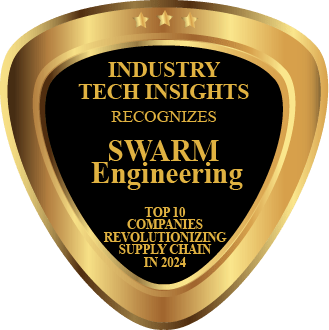
- December 23, 2025 7:00 am
- California

Two years ago, the global supply chain was not a common topic for a dinner party conversation, but now everybody has a view on the disruption, how it impacts them personally, and what should be done to fix it.There are many reasons for the disruption; the pandemic, geopolitics, a lack of truck drivers, wars, weather, climate change, low inventory because of just-in-time methodologies, and the list keeps growing. One of the fundamental underlying issues is that not many of the supply chain processes were built to handle frequently changing, dynamic conditions. California-based SWARM has built an optimization platform for the agri-food supply chain and uniquely uses a multi-agent software architecture (MAS).
MAS are built to handle disruption, and they are inspired by natural systems that have demonstrated the power to manage chaotic, real-world situations.
Think of bees or ants foraging for food and then maximizing the identified food source, whatever obstacles are thrown in their path, or even the way neurons fire and interact in your mind – these are all MAS built to handle complexity. SWARM is a Software-as-a-Service platform that lets business users model their problems in straightforward business terms and then uses AI and the MAS to solve the problems, typically for multi-million-dollar savings. “We solve challenges such as balancing supply and demand, product formulation, inbound or outbound logistics, or resource planning and management – all in highly disruptive environments,” says Anthony Howcroft, CEO of SWARM. Being a detailed oriented leader, Anthony is closely involved in the design of customer solutions, and the product direction. SWARM gives business users easy access to advanced solutions without any software coding, knowledge of advanced AI, or machine learning. SWARM is democratizing AI for the agri-food supply chain.
The SWARM platform, as a MAS, is by its very nature resilient and able to handle disruption. Some customers are now looking at this as a major factor in making a buying decision and love the approach SWARM have taken. Other customers are still trying to cope with macro-level problems and are locked in fire-fighting mode. “We have heard a lot of discussion around resilience and seen some customers taking proactive steps on risk-management. For example, we managed inbound logistics for one food producer, and their primary goal was initially to minimize cost with a variety of constraints based on supply, demand, and transportation across a range of US based facilities receiving raw materials from South America,” explains Anthony. “Post pandemic, we were asked to add constraints to manage risk, so that the supply was not coming from one supplier or being shipped from one region or through one airport. That’s an easy task for us, but it does mean the cost savings are reduced.” Organizations have some interesting decisions now about how much they are prepared to pay to achieve resilience and manage risk more effectively. Like anything, there is a balance, and SWARM is in a great place to help people with that because they can dial up or down the various constraints at a moment’s notice, to automatically find the optimum solution within those new parameters. Even better, they can allow their customers to do that themselves without needing additional services.
According to Anthony, AI is a complex subject that many companies approach with a mix of excitement and trepidation. When one starts to build advanced techniques like deep reinforcement learning into their business processes, they go beyond the capabilities of most business users and many software developers. Even some standard operational research algorithms like those for network optimization can be confusing to those without relevant training. SWARM is democratizing AI by giving everyday users access to these powerful tools without having to understand how they work. “Most of us can drive a car, but we don’t all need to understand how the engine works. We think the same metaphor is true for AI,” explains Anthony. “We let business users define their challenge, in business terms, and then SWARM uses advanced AI to deliver a solution. This makes AI available for everyone. Our immediate focus is on key processes in the agri-food supply chain, although we would love to expand into other markets in the future.”
Recently, the company worked with one major food producer of a well-known breakfast cereal, where they were blending grains and needed to ensure the product remained gluten-free, which meant minimizing the number of barley seeds in a production run. They had a spreadsheet listing the best options, with 10,000 choices. However, when they added a few additional factors into the decision, the number of choices jumped to 85 trillion, and not surprisingly, the spreadsheet couldn’t cope! They used an algorithm to help pick the best blending option to ensure the highest quality product at the lowest cost and, importantly, ensure that production was not stalled because the highest quality grain was used too early in the season. Anthony and his team learned on this project that the operational team on the manufacturing floor was not interested in multi-agent systems, AI, etc. “Our user interface became a simple button that said ‘Blend’. We learnt that the SWARM Ops Dashboard had to be all about ease of use and delivering value – not showing the smart things SWARM was doing to solve the problem.”
For the days to come, the company is rolling out the SWARM Challenge Modeler to an extended group of customers and partners and expect to make the product fully available early fall, at no cost for the personal edition. They are keen on resolving their clients’ challenges in the agri-food supply chain and aim to add more templates built by industry experts into the modeler, to make it even faster and more accessible for people to define their challenges. Currently, SWARM is primarily in North America, although they are dipping a toe into the agri-food world further south. “We also have some enthusiastic followers in adjacent markets like water and energy, who are keen for us to extend our reach. For now, we will remain focused on our core markets, but would not rule out a fund-raise so we could expand into additional markets and territories in the future,” elucidates Anthony.

" We solve challenges such as balancing supply and demand, product formulation, inbound or outbound logistics, or resource planning and management – all in highly disruptive environments. "
Anthony Howcroft
CEO